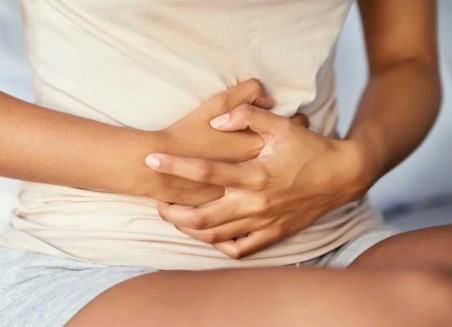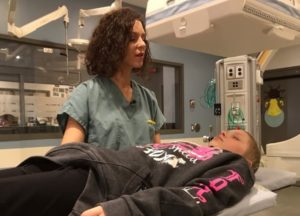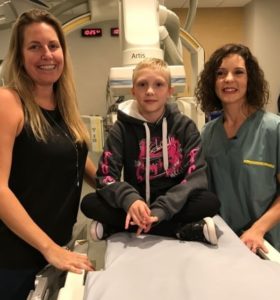


Video: ABC news on IBS relief hypnosis
I have been helping clients with IBS symptoms since 2005.

Hypnosis reduces children’s pain and anxiety
 Some 80 pediatric patients took part in pilot project to test effect of hypnosis during stressful procedures.
Some 80 pediatric patients took part in pilot project to test effect of hypnosis during stressful procedures.
Even in a quick demonstration, Vicky Fortin, medical imaging technologist, was able to guide 9-year-old Koraly Lefrançois into a dreamlike state with hypnosis.
Koraly Lefrançois was diagnosed with Hodgkin’s disease last April and has had to undergo some pretty uncomfortable medical procedures at the Montreal Children’s Hospital since then.
The nine-year-old has had a catheter inserted into a peripheral vein and threaded through to her heart, in order for lifesaving treatments to be injected. She underwent a biopsy when a growth was discovered on her inner thigh.
In both procedures, a local anesthetic was used to ease her pain. But that does little to soothe anxiety.
That’s where hypnosis comes in.
“At first I was stressed, but after, I was less worried,” Koraly said. “The hypnosis calmed me down, and I was fine.”
Koraly is one of about 80 pediatric patients who participated in what is being touted as a successful pilot project at the Children’s — the use of medical hypnosis as a tool to combat stress and pain when undergoing arduous, protracted procedures.
On a pain and discomfort scale of zero to 10 (10 being the highest), the young patients averaged a score of 5.4 without hypnosis, researchers found.
Under hypnosis, the average score drops to 1.4. That’s a huge difference, said Johanne L’Écuyer, chief medical imaging technologist at the  Children’s.
Children’s.
Inspired by hospitals in France
L’Écuyer, who led the project, said the research team started with minor procedures, working their way up to longer, more difficult ones. The project ended in September, and now the use of hypnosis is increasingly common, she said.
“We do more and more. We do even more invasive procedures as we go,” L’Écuyer said.
“The more radiologists are seeing how powerful this is, the more they push to have hypnosis on longer procedures. Once we did a procedure that lasted two hours.”
Johanne L’Écuyer, chief medical imaging technologist at the Montreal Children’s, led the hypnosis pilot project. Hypnosis is now being used more and more, she says. (CBC)
The pilot project was initiated at the urging of Quebec’s order of medical imaging technologists. The order’s director attended a conference in France a few years ago and discovered the practice in use there.
When he returned to the province, he asked L’Écuyer if she’d like to look into it.
 She said she brought a team to France to visit hospitals, and “what we saw there was amazing.”
She said she brought a team to France to visit hospitals, and “what we saw there was amazing.”
Anne Zeestraten, left, says her daughter Koraly Lefrançois benefited from the hypnosis. Vicky Fortin, Koraly’s medical imaging technologist, says she could see her patient dreaming.
Koraly, who is now in remission, would dream while hypnotized, according to her medical imaging technologist, Vicky Fortin. Fortin would tell her young patient a relaxing story while she underwent each procedure.
“You could see her eyes moving under her eyelids, and that tells me that she’s dreaming,” Fortin recalled.”She’s somewhere else. She’s under hypnosis.” Koraly’s mother, Anne Zeestraten, said with the hypnosis, her daughter wasn’t scared when told she had to undergo a second procedure.
“She was like, ‘OK, yeah, just find some other dream.'”
By: Isaac Olson

Is hypnosis safe and effective for treating IBS?
 This study checks out is effective and safe for people suffering from irritable bowel syndrome (IBS).
This study checks out is effective and safe for people suffering from irritable bowel syndrome (IBS).
A total of 464 patients received 7–12 hypnosis sessions over a 12 week period. At the end of therapy, hypnosis proved to be superior in producing adequate symptom relief.
This study demonstrated that hypnosis was safe and provided long-term adequate symptom relief in 54% of IBS patients compared to conventional therapy. [more]

Hypnosis for insomnia in school-age children
 This study assesses the effect of hypnosis for insomnia with school-age children, ranging from ages 7-17, dealing with stressors and medical conditions.
This study assesses the effect of hypnosis for insomnia with school-age children, ranging from ages 7-17, dealing with stressors and medical conditions.
The study included 84 children and adolescents with insomnia. All were instructed in self-hypnosis for treatment of insomnia.
Seventy-five patients returned for follow-up after the first hypnosis session. When insomnia did not resolve after the first instruction session, patients were offered the opportunity to use hypnosis to gain insight into the cause.
Use of hypnosis appears to facilitate efficient therapy for insomnia in school-age children. 87% reported improvement or resolution of the somatic complaints following hypnosis. [more]

Effects of hypnosis & music: breast biopsy
 In an effort to evaluate the reduction of emotional and physical disturbances in patients scheduled for breast biopsy, this study compared audio-recorded hypnosis with background music vs. music without hypnosis. It also included a control group.
In an effort to evaluate the reduction of emotional and physical disturbances in patients scheduled for breast biopsy, this study compared audio-recorded hypnosis with background music vs. music without hypnosis. It also included a control group.
A total of 75 patients were randomly assigned to a group and evaluated before and after breast biopsy for levels of stress, pain, depression, anxiety, fatigue, optimism, and general well-being.
The results showed that, before breast biopsy, the music group presented only less stress and anxiety, whereas the hypnosis group presented reduced stress, anxiety, and depression and increased optimism and general well-being.
After the biopsy, the music group presented less anxiety and pain, whereas the hypnosis group showed less anxiety and increased optimism. [more]









